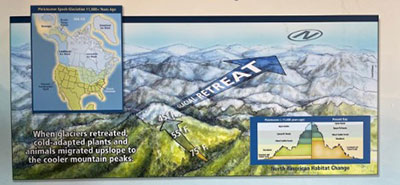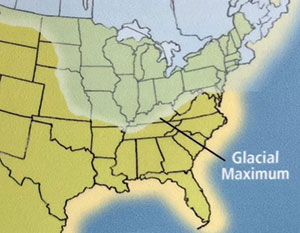
By Tom Champeau, Pisgah Chapter of Trout Unlimited
The Blue Ridge Parkway Visitor Center at Craggy Gardens has an excellent display about Sky Islands; why they support species that originated from northern (boreal) regions of the North American continent, and why these habitats are threatened by climate change.
Over the history of the Earth, ice sheets have migrated from the polar caps many times. The latest major glacial advance period occurred over the past 2.5 million years ending with the Wisconsin Glacial Episode about 11,000 years ago. Since then, glaciers have retreated during the current inter-glacial period as a result of climate warming.
Boreal plant and animal species, including eastern brook trout, had their geographic ranges expand during glaciation into the southeastern part of the country. As the glaciers retreated, these species persisted in the region as the climate warmed, and now exist in the higher elevations. The cool, moist conditions of the southern Appalachian mountains and ridges provide the last remaining refugia for many boreal species, and are referred to as ecological sky islands.

Climate warming is being accelerated by greenhouse gas emissions since the Industrial Revolution. Southern Appalachian Sky Islands will experience reduction in habitats that support many boreal plant communities and animal species.
It is uncertain how future conditions will affect Southern Appalachian Brook Trout (SABT). Scientists don’t know how SABT will adapt to a warmer climate, but know that as water temperatures exceed 70 degrees, SABT survival is reduced. One thing is for sure: More frequent and prolonged periods of water temperatures over 70 degrees will imperil SABT populations in many western North Carolina mountain streams.
Key conservation strategies are the protection of headwater seeps, springs, and tributaries. Protecting and increasing groundwater inputs and riparian tree canopies along streams are critical to maintaining cooler water temperatures.
Collaboration between the North Carolina Wildlife Resources Commission, the U.S. Forest Service, and the Great Smoky National Park, Trout Unlimited, Eastern Brook Trout Joint Venture, and other partners, has resulted in many conservation projects to improve aquatic habitat, increase conductivity between streams, increase SABT population size and genetic diversity, and reduce potential competition from non-native trout. The goals of these projects are to increase resiliency and redundancy of SABT populations by restoring habitat and SABT populations.
Resiliency: Enhance connections between SABT populations by improving water quality throughout watersheds, reducing sedimentation, removing barriers to fish passage, and enhancing aquatic habitat. Resiliency ensures that if environmental events decimate a particular population, SABT from other streams in the watershed can migrate to naturally re-populate impacted streams.

Restoration: SABT population restoration consists of the introduction of SABT into fish-less sections of streams, and removal of non-native trout followed by SABT re-introduction. Sections of streams are selected for restoration by their habitat quality and the presence of waterfalls to prevent upstream migration of non-native trout.
Volunteers with Trout Unlimited chapters from across the Southeast help agencies and other conservation organizations document impacts, monitor brook trout populations, collect water quality and temperature data, and restore habitat. If you are interested in getting involved as a volunteer in the conservation of Southern Appalachian Brook Trout in North Carolina, consider joining your local chapter of Trout Unlimited (https://www.tu.org/chapters/north-carolina/).